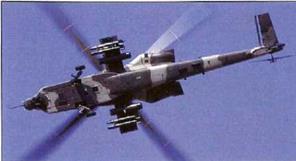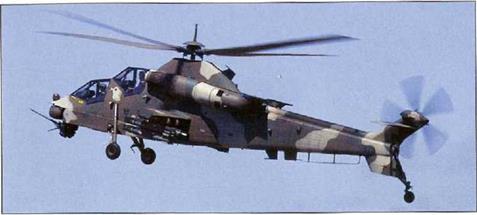DeneK AH-2A Rooivalk
|
|
S |
outh Africa’s Rooivalk (red kestrel) helicopter was designed to meet a 1981 SAAF requirement for an indigenously-designed attack helicopter. The Atlas Aircraft Corporation (renamed Denel Aviation in 1996) began work on a number of technology development aircraft, including the XH-1 weapons testbed (based on an Alouette III airframe) and the XTP-1 (a modified Puma). Experience with these aircraft fed directly into the Rooivalk prototype, the XH-2 (Experimental Helicopter 2), which made its maiden flight in 1990.
The Rooivalk follows the well-proven attack helicopter layout of stepped, twin-tandem seating in a narrow fuselage, with stub wings for weapons carriage, nose-mounted sensors and an undernose cannon. Drawing on South Africa’s substantial combat experience from the ‘Bush War’ conflicts in Namibia and Angola, Atlas designed the Rooivalk as a highly-survivable aircraft able to absorb battle damage while protecting its crew and remaining operational on the battlefield.
Several elements of the Aerospatiale (Eurocopter) Puma design found their way into the Rooivalk – hardly surprising as the Puma was an important type in the SAAF inventory and many were modified and upgraded by Atlas to improved Oryx standard. The
This is the first production-standard AH-2A Rooivalk, seen carrying a load of eight ZT6 Mokopa anti-tank missiles and two 68-mm rocket pods.
Rooivalk has the Puma’s Tudoomeca Turmo IV engine (licence-built as the Topaz in the XDM and ADM) and the same rotor system, The Rooivalk is designed to carry up to 16 Denel ZT6 Mokopa antitank missiles, in addition to rocket pods and Mistral IR-guided anti-aircraft missiles. The 20-mm undernose cannon is linked to a helmet-mounted sight The XH-2 prototype was refined to serve as the XDM (Experimental Development Model) which first flew on 11 February 1990. A second prototype was built as the ADM (Advanced Demonstration Model), and it first flew in 1992. A third pre-production Rooivalk, the EDM (Engineering Development Model! flew on 17 November 1996. In 1996 the South African Air Force signed an order for 12 Rooivalks, with the service designation AFI-2A (previously CSH-2). The first deliveries were made in January 1999, and the SAAF has a requirement for up to 36 additional aircraft.
An export version of the Rooivalk was a strong contender for the British Army’s attack helicopter requirement in 1993/94 and a version dubbed the RedFlawk was offered for Australia’s Air 87 com petition in 2000/01. Malaysia announced an initial deal for eight Rooivalks in 1998, but a firm order remains as yet unsigned

|












